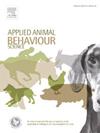Having a gander at goose behaviour. Evaluating time-activity of captive and wild geese at two different wetland sites
IF 2
2区 农林科学
Q1 AGRICULTURE, DAIRY & ANIMAL SCIENCE
引用次数: 0
Abstract
Geese are not common subjects for behavioural investigation in zoological facilities, despite their popularity in waterfowl collections and their complex ecological needs. This research evaluated time-activity budgets of six goose species located at two UK Wildfowl & Wetland Trust (WWT) centres, comparing captive population behaviours with two species of wild goose. Using a standardised ethogram and instantaneous focal sampling, we recorded over 220 h of behavioural data across 892 observations. All data were recorded in spring and summer of 2015, 2017 and 2018. Data were analysed using linear mixed models and zero-inflated models to account for high frequencies of zero occurrences in alert and social behaviours. Results show that whilst captive and wild geese broadly perform similar species-typical behaviours, captive birds exhibited higher levels of resting and lower social engagement. Foraging and locomotion differed significantly by species, and this may be a factor of ecological niche. Minimal stereotypic behaviour (<2 % of observations) was recorded in the captive birds, suggesting that the large, naturalistic enclosures provided by WWT support positive welfare by enabling appetitive behaviours, such as grazing. However, high inactivity rates highlight the need for further enrichment and dynamic enclosure management to be considered to further improve goose behavioural diversity. Comparisons with wild geese provide useful benchmarks for evaluating behavioural normality under human care. This research supports the use of time-activity budgets as a practical tool for developing evidence-based, species-specific husbandry guidelines. We recommend future research focusses on long-term, individual-bird behavioural monitoring, seasonal comparisons, and the incorporation of personality profiling to further our understanding of how geese respond to their captive care at the population, species and individual bird level.
观察鹅的行为。圈养鹅和野鹅在两个不同湿地的时间活动评价
尽管鹅在水禽收藏中很受欢迎,并且有复杂的生态需求,但鹅并不是动物设施中行为调查的常见对象。本研究评估了位于两个英国野禽保护区的6种鹅的时间活动预算。湿地信托基金(WWT)中心,比较圈养种群与两种大雁的行为。使用标准化的谱图和瞬时焦点采样,我们记录了892次观察中超过220 h的行为数据。所有数据均记录于2015年、2017年和2018年春夏。使用线性混合模型和零膨胀模型分析数据,以解释警报和社会行为中零发生的高频率。结果表明,虽然圈养鹅和野生鹅的行为大致相似,但圈养鸟表现出较高的休息水平和较低的社会参与水平。不同物种的觅食和移动方式存在显著差异,这可能与生态位有关。在圈养鸟类中记录了最小的刻板行为(<;2 %的观察结果),这表明WWT提供的大型自然围栏通过促进食欲行为(如放牧)来支持积极的福利。然而,高不活动率突出了进一步丰富和动态圈养管理的必要性,以进一步改善鹅的行为多样性。与大雁的比较为评估人类护理下的行为正常性提供了有用的基准。这项研究支持将时间活动预算作为制定基于证据的、特定物种的畜牧业指南的实用工具。我们建议未来的研究集中在长期的、个体鸟的行为监测、季节比较和个性分析的结合上,以进一步了解鹅在种群、物种和个体水平上对圈养护理的反应。
本文章由计算机程序翻译,如有差异,请以英文原文为准。
求助全文
约1分钟内获得全文
求助全文
来源期刊

Applied Animal Behaviour Science
农林科学-行为科学
CiteScore
4.40
自引率
21.70%
发文量
191
审稿时长
18.1 weeks
期刊介绍:
This journal publishes relevant information on the behaviour of domesticated and utilized animals.
Topics covered include:
-Behaviour of farm, zoo and laboratory animals in relation to animal management and welfare
-Behaviour of companion animals in relation to behavioural problems, for example, in relation to the training of dogs for different purposes, in relation to behavioural problems
-Studies of the behaviour of wild animals when these studies are relevant from an applied perspective, for example in relation to wildlife management, pest management or nature conservation
-Methodological studies within relevant fields
The principal subjects are farm, companion and laboratory animals, including, of course, poultry. The journal also deals with the following animal subjects:
-Those involved in any farming system, e.g. deer, rabbits and fur-bearing animals
-Those in ANY form of confinement, e.g. zoos, safari parks and other forms of display
-Feral animals, and any animal species which impinge on farming operations, e.g. as causes of loss or damage
-Species used for hunting, recreation etc. may also be considered as acceptable subjects in some instances
-Laboratory animals, if the material relates to their behavioural requirements
 求助内容:
求助内容: 应助结果提醒方式:
应助结果提醒方式:


